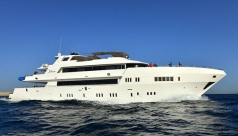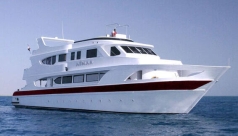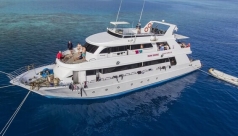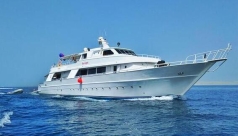Dunraven Wreck
The 80m long Dunraven steamship was built in Newcastle, England in 1873. In March 1876, on her voyage up the Suez from India to the UK, she ran on to the reef and stuck fast off Shaab Mahmoud, south of Sharm El Sheikh. The crew worked frantically for 14 hours to dislodge her but she capsized and sank to the seabed at 30m with her cargo of cotton and wool. The crew were eventually rescued by local fishermen.
The wreck was only rediscovered in 1979 and now lies in 2 pieces, with its stern and large brass propeller to the north and the reef of the Sinai Peninsula to the west. It's possible to dive the entire length of the ship's interior so enter at the deepest section - the stern. The cavernous hull of the Dunraven is adorned with soft corals and black corals and is full of schooling goatfish and glassfish, squirrelfish and a few groupers and
moray eels. Pass some ballast stones, the large boiler room and several breaks in the hull until you reach the bow at 15m. Here you can ascend and swim back along the upper surface of the ship.
The exterior of the Dunraven's hull is now covered in hard corals, with sea whips and gorgonians hanging from the vertical sections. It's a great place to spot nudibranchs, crocodilefish, scorpionfish and colourful clouds of fairy basslets. Rather than ascending up the buoy line to end your dive, you might choose instead to swim over the the reef slope. This is one of the top Sharm El Sheikh sites for fish density - the marine life here is very lively with a good chance to
see Napoleon wrasse and turtles.
Overall, the Dunraven may not offer the spectacular artifacts of the Thistlegorm but then it doesn't attract huge crowds of scuba divers from Sharm either, so it will definitely be worth your while to include it in your Red Sea holiday.
Ras Ghamila
'Delightful Cape', as Ras Ghamila means in Arabic, is the most northern of Sharm El Sheikh's local dive sites. It lies almost directly opposite Gordon Reef and separates a shallow, sandy lagoon from the sea. It is easy to find because it is the tongue of the reef that juts out eastwards upon which stand a green beacon to mark the western end of the Strait of Tiran.
The topography of the site is very simple with a relatively shallow fringing reef, and an extensive plateau that ranges in depth from 14-26m. The plateau is covered with coral bommies, huge table corals and the largest number of gorgonian sea fans at any of the dive sites around Sharm. Fantail rays, groupers and
turtles can often be spotted here. As your air slowly reduces, allow the current to push you gently towards the beacon to end your dive in the shallows there.
Ras Mohammed
Still Egypt's most popular marine park, Ras Mohamed's waters off the tip of the Sinai Peninsula have been protected from fishing since the 1980s, and it shows ... Drifting along the wall from Shark Reef to Yolanda Reef, you are often likely to encounter passing trevally and barracuda that frequent the region for breeding. The reefs have become safe havens to many of the
Red Sea's endemic fish species.
> [More details:
Ras Mohammed]
Ras Um Sid
This dive site is located at the north end of Sharm El Sheikh Harbour. It is one of the most exciting local sites since it has a varied topography, as well as fast currents and the potential of pelagic sightings.
The site has a coral shelf that follows the shoreline. The dive starts at the south side of the headland (‘Ras’ is an Arabic word for ‘Cape’) with a steep wall drop off to 20-25 metres which has a superb gorgonian forest. The wall gives way to a large plateau that swarms with marine life. The hard coral pinnacles and heads of acropora and fire corals host scorpionfish, lionfish, morays, nudibranchs and schools of batfish. Blue-spotted sting rays and crocodilefish can be found on the intermittent sandy patches. Larger fish found here include angelfish, triggerfish, parrotfish and yellowspine surgeonfish.
If there is a current then there is a chance for scuba divers to see Napoleon wrasse, and schools of snappers, jacks and barracuda at the corner. Be careful not to get swept away by the current as this will make it impossible to return to the exit point.HMS Thistlegorm
With its historical cargo of World War II machinery and equipment, all neatly stowed in its open holds, the wreck of the Thistlegorm would be a highlight of diving anywhere in the world, not just in Sharm El Sheikh. It couldn't have been more conveniently located for diver exploration if it had been scuttled for the very purpose rather than sunk by German bombers. This most famous of Sinai dives and the most popular dive site in the world, has to be experienced several times to truly appreciate all its wonders.
> [More details:
HMS Thistlegorm]
Tiran Strait
At the entrance to the Gulf of Aqaba, the 4 reef systems that make up the Tiran area - Jackson, Woodhouse, Thomas and Gordon reefs - are popular with experienced and adventurous Sharm El Sheikh.divers. The coral reef plateaus that feature unpredictable currents are loaded with fish life and the deep wall drop offs offer excellent visibility with the opportunity of encounters with hammerhead sharks, pelagic fish and
occasional tiger sharks. Coral reef health and fish densities are among the best in the northern Red Sea.
> [More details:
Tiran Strait]
SS Turkia
The SS Turkia is one of the very best wrecks in the Red Sea yet it is little-dived due to its location being off the usual routes taken by liveaboard boats. Like the SS Thistlegorm, it was a ship that was loaded with World War 2 paraphernalia when it sank, and it attracts a large amount of marine life.
Built in Hull in 1909 by Earles Shipbuilding and Engineering Co. as the Livorno (11) , she was a 90m/300 ft long schooner-rigged steam cargo ship, on a voyage from New York, USA, to Piraeus in Greece. It was May 1941 and the Turkia was loaded with explosives, tires, coils of wire, ingots, vehicles and firearms. Since the Straits of Gibraltar were closed, the ship had to navigate the Red Sea from the southern end and then enter the Gulf of Suez. It is thought that a fire broke out when the vessel was just off the lighthouse at Zafarana. The fire was in one of the holds carrying explosives so the Turkia was abandoned, just before the ship was sunk by a large explosion.
The wreck now sits upright on sand in 24m of water, with the bow facing towards the shore, engulfed in circling fish. The hull is intact, although some sections have holes appearing in the upper sections. Both masts have been severed below the water line and lie off to the side of the wreck. The surrounding seabed is littered with debris from the wreck and is patrolled by trevallies.
The focsle hatch allows easy access for divers to explore the crew’s accommodation; the frames of the bunk beds can still be seen. There are coils of wire and vehicle tyres littered all about. Mussels encrust most of the structures. The deeper sections of the holds contain wooden crates containing hundreds of brass detonator caps and heavy rubber bases. There are also several vehicles, heavily encrusted. They appear to be cabs with extended chassis, possibly tank transporters or ambiulances.
















































